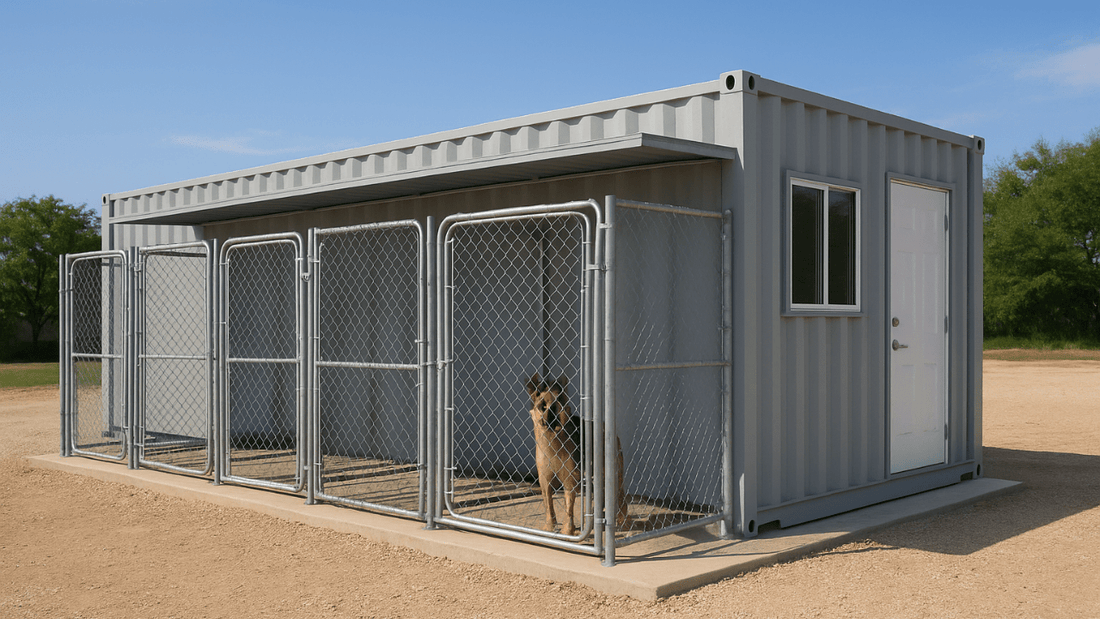
Shipping Container Kennels: Cost-Effective Solutions for Pet Owners, Boarding Businesses, and Rescue Organizations
Share
Repurposing shipping containers into comfortable, secure, and climate-controlled dog kennels not only conserves resources but also opens up a world of possibilities for pet owners, breeders, rescue organizations, and boarding facilities.
Why Use a Shipping Container for a Kennel?
Standard containers are made from corten steel, built to endure the high seas, which makes them practically indestructible in most weather conditions. Their rigid frame, wind- and water-resistant properties, and stackability make them ideal for modular kennel systems, especially in rural or off-grid locations. More importantly, they offer a blank canvas. Unlike pre-fab kennels, you dictate every square inch of layout, ventilation, and functionality.
Planning Your Container Kennel Conversion
Before breaking out the power tools, map out your needs. Are you housing one dog or a dozen? Will the kennel serve as a temporary shelter, a full-time home, or part of a grooming or training facility? These answers will inform your floorplan, ventilation requirements, and interior design.
Step 1: Choose the Right Container
Most conversions start with a standard 20- or 40-foot container. The 20-footer is ideal for backyard use, whereas the 40-foot model accommodates multiple runs or a combination of kennel and storage space. You’ll want one labeled “one-trip” or “wind and watertight” for the best condition.
Step 2: Insulation and Climate Control
Proper insulation is essential. Spray foam is popular for its thermal efficiency, but reflective insulation combined with plywood paneling also works well. Install HVAC units or portable climate systems to maintain a comfortable interior temperature. If electricity isn’t readily available, solar-powered ventilation and fans provide low-cost alternatives.
Step 3: Flooring and Drainage
Original container floors are often treated plywood—not ideal for canine use. Rip it out and replace it with sealed concrete, rubberized kennel flooring, or epoxy-coated surfaces that are easy to sanitize and tough enough to resist claw damage. Include a slight slope and floor drain for effortless cleaning. Sanitation is critical to avoid odor buildup and reduce disease risk.
Step 4: Doors, Windows, and Runs
Cutting steel is no small task, so hire a metal fabricator unless you’re experienced with plasma cutting tools. Create secure openings for entry doors, doggy access doors, and windows. Each kennel stall should open to a separate outdoor run, preferably enclosed with chain-link fencing or welded wire panels. Transparent polycarbonate windows allow natural light while maintaining durability.
Step 5: Ventilation and Lighting
Cross-ventilation is vital to reduce heat and humidity. Consider installing louvered vents on opposite walls or roof-mounted turbine vents to promote air circulation. LED strip lights or motion-sensor fixtures work well for interior lighting, offering bright, energy-efficient illumination.
Custom Features to Add to Your Shipping Container Kennel Conversion
A shipping container kennel doesn’t have to feel industrial. With some creative upgrades, it can rival the comfort of a traditional building:
-
Partitioned Stalls: Use galvanized steel panels or waterproof composite boards to separate kennel spaces.
-
Feeding Stations: Built-in feeding shelves and water bowls can reduce mess.
-
Soundproofing: Adding acoustic panels or insulation not only quiets barking but also keeps external noise from agitating the dogs.
-
Security: Install heavy-duty locks, motion-detection cameras, and alarms to protect your kennel.
Regulatory Considerations
Before starting any build, check with your local zoning office. Some areas classify shipping containers as temporary structures, while others require permanent foundation work. Also, verify kennel licensing requirements, especially if housing multiple dogs or operating a commercial facility.
Sustainability and Cost Efficiency
Turning a shipping container into a kennel aligns with eco-conscious building practices. Instead of sourcing new materials, you’re giving a second life to industrial surplus. Solar panels, rainwater collection systems, and low-energy climate control further reduce your footprint. Financially, this type of build is often far less expensive than traditional construction. While costs vary, you can often complete a functional shipping container kennel for far less than the six-figure price tags attached to custom masonry structures.
Transforming a shipping container into a dog kennel is a practical, long-lasting solution. Whether you're running a commercial boarding business or just want a safe, cozy place for your pets, a shipping container kennel checks every box: durability, flexibility, and efficiency. With thoughtful design and attention to detail, your steel structure can become a true canine retreat.
Fill out the form below for a free shipping container quote from USA Containers:
